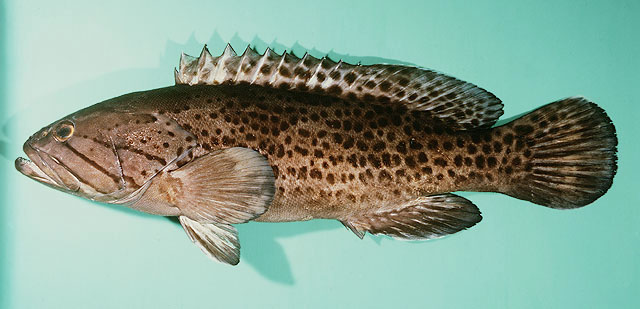| Epinephelidae (Groupers) |
| 87 cm TL (male/unsexed); max.weight: 8,650.0 g |
|
reef-associated; brackish; marine; depth range - 101 m |
| Southeast Atlantic and Western Indian Ocean: known with certainty only from the southeast coast of Africa between Quissico, Mozambique (24°50'S) and Knysna, South Africa (23°E). Reports from Madagascar are dubious. |
|
Dorsal spines (total): 11-11; Dorsal soft rays (total): 13-15; Anal spines: 3-3; Anal soft rays: 8-8. Distinguished by the following characteristics: head, body and fins brown; body, caudal and dorsal fins with numerous small close-set irregular dark brown spots; 2 dark brown stripes running posteriorly from the eye across operculum, and another continuing from the maxillary groove to the lower edge of the preopercle; body elongate, depth 3.2-3.7 times in SL; greatest body width 1.4-1.8 times in body depth; head length 2.4-2.7 times in SL; angular preopercle, with several enlarged serrae at the angle; upper edge of operculum slightly convex; posterior and anterior nostrils equal; scaly maxilla, reaching to or past vertical at rear edge of eye; 2-3 rows of teeth on midside of lower jaw; rounded caudal fin; ctenoid midlateral-body scales (mostly embedded), with auxiliary scales (Ref. 089707). |
| Adults inhabit reefs and rocky bottom to a depth of at least 101 m (Ref. 089707); juveniles are found in tide pools. Feed on fishes and crustaceans. Sexual maturity is attained at 50 to 60 cm. Are diandric protogynous hermaphrodites unlike that of other congeners (Ref. 74502). |
|
Near Threatened (NT); Date assessed: 20 November 2016 (A2bd) Ref. (130435)
|
| harmless |
Source and more info: www.fishbase.org. For personal, classroom, and other internal use only. Not for publication.

